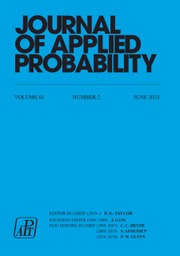Article contents
Unified approach for solving exit problems for additive-increase and multiplicative-decrease processes
Published online by Cambridge University Press: 30 August 2022
Abstract
We analyse an additive-increase and multiplicative-decrease (also known as growth–collapse) process that grows linearly in time and that, at Poisson epochs, experiences downward jumps that are (deterministically) proportional to its present position. For this process, and also for its reflected versions, we consider one- and two-sided exit problems that concern the identification of the laws of exit times from fixed intervals and half-lines. All proofs are based on a unified first-step analysis approach at the first jump epoch, which allows us to give explicit, yet involved, formulas for their Laplace transforms. All eight Laplace transforms can be described in terms of two so-called scale functions associated with the upward one-sided exit time and with the upward two-sided exit time. All other Laplace transforms can be obtained from the above scale functions by taking limits, derivatives, integrals, and combinations of these.
Keywords
MSC classification
Information
- Type
- Original Article
- Information
- Copyright
- © The Author(s), 2022. Published by Cambridge University Press on behalf of Applied Probability Trust
References
- 5
- Cited by


